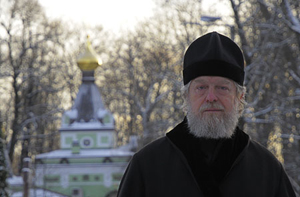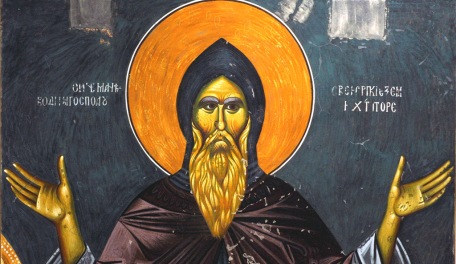 On January 24/ February 6, the Russian Orthodox Church celebrates the memory of St. Xenia of St. Petersburg. The story of this woman, who for the sake of serving God and man renounced everything, still amazes and causes wonder. We asked the rector of the Church of the Smolensk Icon of the Mother of God and the chapel of St. Xenia in St. Petersburg, Archpriest Viktor Moskovsky, about the personality, the canonization history, and the spiritual labors of St. Xenia of St. Petersburg, and also about what is a fool-for-Christ and whether they exist in our times.
On January 24/ February 6, the Russian Orthodox Church celebrates the memory of St. Xenia of St. Petersburg. The story of this woman, who for the sake of serving God and man renounced everything, still amazes and causes wonder. We asked the rector of the Church of the Smolensk Icon of the Mother of God and the chapel of St. Xenia in St. Petersburg, Archpriest Viktor Moskovsky, about the personality, the canonization history, and the spiritual labors of St. Xenia of St. Petersburg, and also about what is a fool-for-Christ and whether they exist in our times.
Science
Hieromartyr Charalampus (Haralambos) the Bishop of Magnesia in Thessaly
22. February 2018 - 16:27 The Hieromartyr Charalampus, Bishop of Magnesia, the Martyrs Porphyrius and Baptus and Three Women Martyrs suffered in the year 202.
The Hieromartyr Charalampus, Bishop of Magnesia, the Martyrs Porphyrius and Baptus and Three Women Martyrs suffered in the year 202.
Saint Charalampus, Bishop of Magnesia (Asia Minor), successfully spread faith in Christ the Savior, guiding people on the way to salvation. News of his preaching reached Lucian, the governor of the district, and the military commander Lucius. The saint was arrested and brought to trial, where he confessed his faith in Christ and refused to offer sacrifice to idols.
The Great Canon of St Andrew of Crete
20. February 2018 - 14:09
There is no other sacred hymn which compares with this monumental work, which St Andrew wrote for his personal meditations. Nothing else has its extensive typology and mystical explanations of the scripture, from both the Old and New Testaments. One can almost consider this hymn to be a “survey of the Old and New Testament”. Its other distinguishing features are a spirit of mournful humility, hope in God, and complex and beautiful Trinitarian Doxologies and hymns to the Theotokos in each Ode.
The Life of Venerable Simeon the Myrrh-Gusher
17. February 2018 - 9:06 On February 26th (February 13th according to Julian calendar) we commemorate: The Venerable Simeon (Myrrh-Gusher), from whose relics flowed myrrh – Chrism
On February 26th (February 13th according to Julian calendar) we commemorate: The Venerable Simeon (Myrrh-Gusher), from whose relics flowed myrrh – Chrism
Stefan Nemanja, the great ruler (Great Zupan) of the Serbian people, the consolidator of Serbian lands, creator of the independent Serbian state, defender of Orthodoxy and exterminator of heresy. At first, he was baptized in the Latin Church but later left this Church and embraced the Orthodox Church.
Martyr Tryphon of Lampsacus Near Apamea in Syria
14. February 2018 - 10:21 The Martyr Tryphon was born in Phrygia, one of the districts of Asia Minor, in the village of Lampsacus. From his early years the Lord granted him the power to cast out demons and to heal various maladies. He once saved the inhabitants of his native city from starvation. Saint Tryphon, by the power of his prayer, turned back a plague of locusts that were devouring the grain and devastating the fields.
The Martyr Tryphon was born in Phrygia, one of the districts of Asia Minor, in the village of Lampsacus. From his early years the Lord granted him the power to cast out demons and to heal various maladies. He once saved the inhabitants of his native city from starvation. Saint Tryphon, by the power of his prayer, turned back a plague of locusts that were devouring the grain and devastating the fields.
Feast of the Three Holy Fathers, Great Hierarchs and Ecumenical Teachers, Basil the Great, Gregory the Theologian, and John Chrysostom
12. February 2018 - 1:33 During the reign of the Emperor Alexius Comnenus (1081-1118), a controversy arose in Constantinople among men learned in Faith and zealous for virtue about the three holy Hierarchs and Fathers of the Church, Basil the Great, Gregory the Theologian and John Chrysostom. Some argued for Saint Basil above the other two because he was able, as none other, to explain the mysteries of the Faith, and rose to angelic rank by his virtues. Organizer of monastic life, leader of the entire Church in the struggle with heresy, austere and demanding shepherd as to Christian morals, in him there was nothing base or of the earth. Hence, said they, he was superior to Saint Chrysostom who was by nature more easily inclined to absolve sinners.
During the reign of the Emperor Alexius Comnenus (1081-1118), a controversy arose in Constantinople among men learned in Faith and zealous for virtue about the three holy Hierarchs and Fathers of the Church, Basil the Great, Gregory the Theologian and John Chrysostom. Some argued for Saint Basil above the other two because he was able, as none other, to explain the mysteries of the Faith, and rose to angelic rank by his virtues. Organizer of monastic life, leader of the entire Church in the struggle with heresy, austere and demanding shepherd as to Christian morals, in him there was nothing base or of the earth. Hence, said they, he was superior to Saint Chrysostom who was by nature more easily inclined to absolve sinners.

